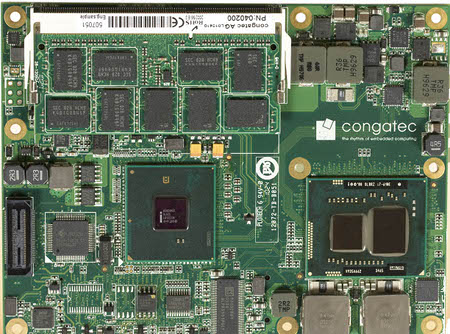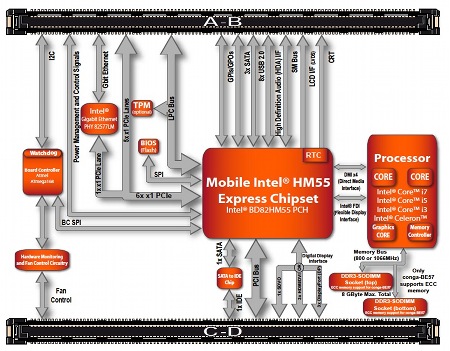COM Express module features ECC memory
Nov 10, 2010 — by LinuxDevices Staff — from the LinuxDevices Archive — 5 viewsCongatec announced a COM Express module that offers ECC (error correction code) memory and a choice of Intel Celeron or Core i7 processors. The Conga-BE57 supports up to 8GB of RAM, provides two independent video channels, and delivers expansion including five PCI Express lanes, eight USB ports, and three SATA ports, the company says.
A January 2010 COM Express module from Congatec, the Conga-BM57, adopted Intel's then-new, 2.66GHz Core i7-620M along with the chipmaker's QM57 Express chipset. A few months later, though we did not cover it at the time, Congatec released the Conga-BS57, featuring the 2.0GHz Core i7-620LE, the 1.06GHz Core i7-620UE, or the 2.13GHz Core i3-330E.
Despite retaining the "57" in its name, the Conga-BS57 switched from the QM57 to the HM55 Express. Broadly similar, this somewhat-simplified chipset apparently does not include Intel's AMT (active management technology) 6.0, has two fewer USB 2.0 ports, includes six PCI Express x1 lanes instead of eight, and includes four SATA ports instead of six.

Congatec's Conga-BE57
(Click to enlarge)
Congatec is now offering the Conga-BE57 — yes, still with "57" in the name — which is similar to the BS57, but now includes support for ECC memory. According to the company, the increased reliability that results makes the module "ideal for demanding applications in medical technology, server systems, and the aviation industry."
Congatec's product page for the BE57 links to the data sheet for the BS57, suggesting that EEC support aside, the two products are pretty much identical. However, the BE57 is offered only with a 1.0GHz Celeron U3405 processor (18-Watt TDP) or a 2.53GHz Core i7-610E (25-Watt TDP). Up to 8GB of DDR3 memory is supported via two DIMM slots, the company adds.

A block diagram of Congatec's Conga-BE57
(Click to enlarge)
A Type 2 COM Express device, the BE57 has dual, 220-pin A-B and C-D connectors (as depicted on the block diagram above), relaying all of its signals to separately available baseboards. According to Congatec, the device includes five PCI Express lanes, eight USB 2.0 ports, three SATA ports, an optional EIDE port, and a gigabit Ethernet interface. A 32-bit PCI bus, LPC, I2C, and high-definition audio are also listed as part of the feature set.
Congatec says the integrated graphics controller uses Intel's FDI (flexible display interface), allowing the device to support two independent video channels. Supported display types include VGA, LVDS, HDMI, SDVO, and DisplayPort, the company adds.
According to Congatec, the BE57 also offers a multi-stage watchdog timer and a TPM (trusted platform module). Operating system support includes Linux 2.6, Windows 7, Windows XP, Windows Embedded Standard (2009 and 7), and QNX 6.x, according to the company.
Features and specifications listed by Congatec for the Conga-BE57 include:
- Processor — 1.0GHz Celeron U3405 processor (18 Watt TDP) or 2.53GHz Core i7-610E (25 Watt TDP)
- Chipset — HM55 Express
- Memory — Up to 8GB of DDR3 ECC memory via two SODIMM slots
- Expansion (all via COM Express connectors):
- 5 x PCI Express lanes
- 32-bit PCI
- 2 x ExpressCard
- Networking — gigabit Ethernet
- Other I/O:
- 8 x USB 2.0
- 3 x SATA
- EIDE (optional)
- LPC
- I2C
- high-definition audio
- VGA
- LVDS
- HDMI
- SDVO
- DisplayPort
- Power requirements — n/s
- Operating range — 32 to 140 deg. F (0 to 60 deg. C)
- Dimensions — 4.92 x 3.74 inches (125 x 95mm)
Further information
Congatec did not cite pricing or availability for the Conga-BE57, but the device appears to be on sale now. More information may be found on the company's website, here.
This article was originally published on LinuxDevices.com and has been donated to the open source community by QuinStreet Inc. Please visit LinuxToday.com for up-to-date news and articles about Linux and open source.